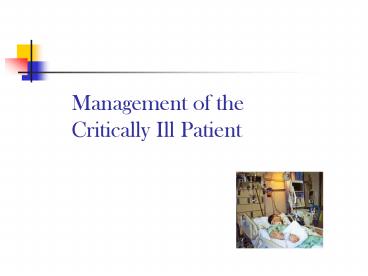Management of the Critically Ill Patient - PowerPoint PPT Presentation
1 / 13
Title:
Management of the Critically Ill Patient
Description:
Supine positioning predisposes to reflux and aspiration. Maintaining a 30 degree head ... Early enteral feeding reduces infection, stress ulcers, and GI bleeds ... – PowerPoint PPT presentation
Number of Views:8261
Avg rating:3.0/5.0
Title: Management of the Critically Ill Patient
1
Management of the Critically Ill Patient
2
Guidelines
- Regular review of monitored trends and response
to therapy - Reassess the care plan
- Adjust prescriptions
- Respiratory Care
- Assisted cough, deep breathing, and alveolar
recruitment techniques - Suctioning/trach care
3
Guidelines, cont
- Cardiovascular Care
- Prolonged immobility impairs autonomic vasomotor
responses to sitting and standing - Causes postural hypotension
- GI Care
- Supine positioning predisposes to reflux and
aspiration - Maintaining a 30 degree head-up position reduces
this - Early enteral feeding reduces infection, stress
ulcers, and GI bleeds - Immobility is associated with gastric stasis and
constipation
4
Guidelines, cont
- Neuromuscular
- Immobility, sedation, and paralysis promote
muscle atrophy, joint contractures, and foot drop - Splints and PT can help
- Comfort and Reassurance
- Anxiety, discomfort, and pain must be recognized
and relieved - Clocks help patients maintain day/night pattern
5
Guidelines, cont
- Communication
- Repeated explanations and reassurance may be
needed due to medication use - Use communication aids
- Venous Thrombosis
- Immobility, trauma, sepsis, and surgery
predispose to deep vein thromboses - Mechanical and pharmacological treatment can help
prevent PE
6
Guidelines, cont
- Infection Control
- HANDWASHING!!
- Standard Precautions
- Thorough cleaning between patients
- Skincare/Hygiene/Mouthcare
- Pressure sores can develop due to pressure,
friction, malnutrition, edema, ischemia, and
damage from moist/soiled skin - Turning every 2 hours helpsspecial beds can
assist with turning - Mouth care and general hygiene are essential
7
Guidelines, cont
- Fluid/Electrolyte Balance
- Regularly assess fluid balance
- Maintaining normal blood sugar improves
outcomes/speeds recovery - Bladder care
- Catheters can cause urethral ulcers
- Catheters can also promote UTI
- Dressing/Wound Care
- Replace dressings regularly, following proper
technique
8
Guidelines, cont
- Family
- Family members get info from all different
caregivers with varying levels of understanding
and expertise, which can be confusing - There should be only a few primary contacts to
keep information giving consistent and
appropriate - Treat family compassionately they are worried
about their loved one and may act inconsiderately - Visiting Hours
- Some units restrict visits to allow for rest
others dont
9
Organization
- There are 5 basic levels of care
- Level 3 ICU
- Level 2 Intermediate/Stepdown areas
- Includes PACU/RR, ED
- Med/Surg areas
- Level 1 admission wards
- Overlaps with level 2 a lot
- General wards
- Minimal care wards
10
Admission/Discharge
- Guidelines can facilitate use of resources and
processing of patient through the facility - diagnosis, severity, likely success of tx,
comorbid illness, life expectancy, quality of
life, and patient/family wishes need to be
considered - If there is uncertainty, admit the patient
- Discharge should occur when the patient is
physiologically stable and the reason for
admission has been resolved
11
Scoring Systems
- APACHE II
- Acute physiology and chronic health evaluation
- Predicts outcomes in ICU patients as a group but
should be used to predict individual outcome - Looks at primary disease process as well as 12
different physiological variables (eg-HR, BP, RR,
WBC) then predicts mortality - Units can compare themselves to other ICUs and
see if their mortality rate is similar for a
diagnostic group - SAPS
- Simplified acute physiology score
- Similar to the Apache II
12
Scoring Systems, cont
- Pathology-Specific scoring systems
- Trauma Score (TS)
- RR, resp effort, systolic BP, cap refill, and
Glascow coma score are integrated to assess
patient status - High scores mean the person needs a trauma center
- Abbreviated injury scale
- Correlates injuries with morbidity and mortality
13
Cost of Critical Care
- Most of the ICU cost is labor
- About 40 of spending is on drugs, imaging, lab
tests, and supplies - Cost saving usually involves reduction in force
(fewer staff) which risks reducing the quality of
care - Daily basic ICU costs in the UK are 800-1600
(how many is this?) - 13 of the gross domestic product in the US is
spent on healthcare with critical care 7 of the
total expenditurethe GDP for the 3rd quarter of
2006 was 13,327.1 billion dollars how much was
spent on healthcare during this quarter (in
dollars)?





![[PDF] Feeding the Critically Ill & GI Compromised: Essential Nutrition Support Skills for New Providers Paperback – May 14, 2024 Kindle PowerPoint PPT Presentation](https://s3.amazonaws.com/images.powershow.com/10076386.th0.jpg?_=20240710101)

























